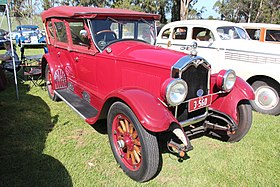| Buick Standard Six | |
|---|---|
 1925 Buick Standard Six | |
| Overview | |
| Manufacturer | Buick (General Motors) |
| Model years | 1925-1928 |
| Assembly | Buick City, Flint, Michigan, United States[1] |
| Body and chassis | |
| Layout | Front-engine, rear-wheel-drive[1] |
| Platform | GM A platform |
| Related | McLaughlin-Buick |
| Powertrain | |
| Engine | 191 cu in (3.1 L) Buick Straight-6 engine OHV I6 207 cu in (3.4 L) Buick Straight-6 engine OHV I6 239.1 cu in (3.9 L) Buick Straight-6 engine OHV I6 |
| Transmission | 3-speed synchromesh manual[1] |
| Dimensions | |
| Wheelbase | 114.5 in (2,908 mm) |
| Chronology | |
| Predecessor | Buick Six |
| Successor | Buick Series 40[1] Buick Series 50[1] |
The Buick Standard Six Series 20 was manufactured by Buick at what would later become known as the Buick City factory on Hamilton Ave. in Flint, Michigan, and was the junior model to the Buick Master Six between 1925 through 1929, and shared the GM A platform with Oldsmobile, Oakland and Chevrolet.[2][1] The Standard Six evolved from the earlier Buick Six when the Buick 4-cylinder was cancelled. The Standard Six was the most popular Buick sold while being more upscale to the Oldsmobile Six. It was the senior brand to Marquette under the General Motors Companion Make Program until Marquette was cancelled one year later. It replaced the earlier Buick Six that was introduced in 1916, and was replaced with the Buick Series 50. Coachwork continued to be offered by Fisher Body who was the primary supplier of all GM products at this time, and Duco automotive lacquer paint, introduced by DuPont was the first quick drying multi-color line of nitrocellulose lacquers made especially for the automotive industry.[1]
